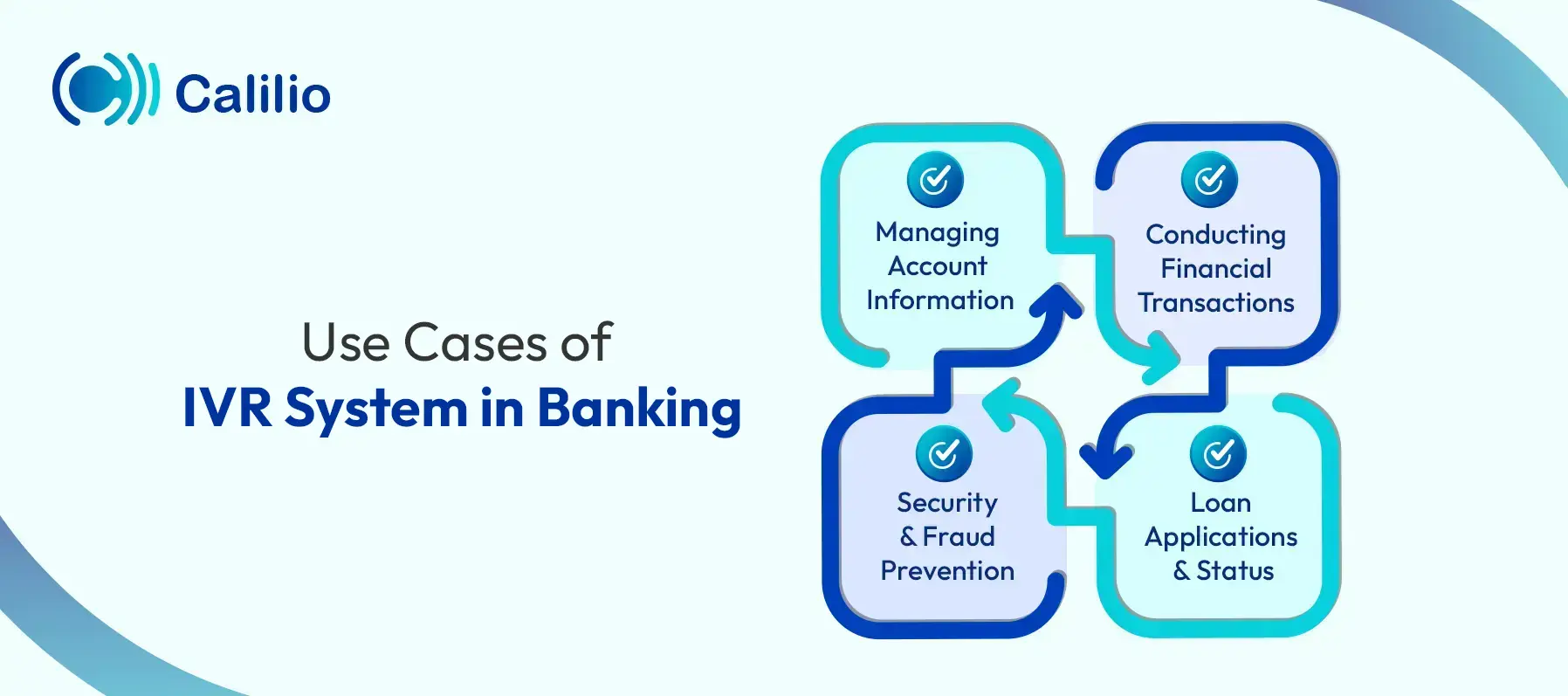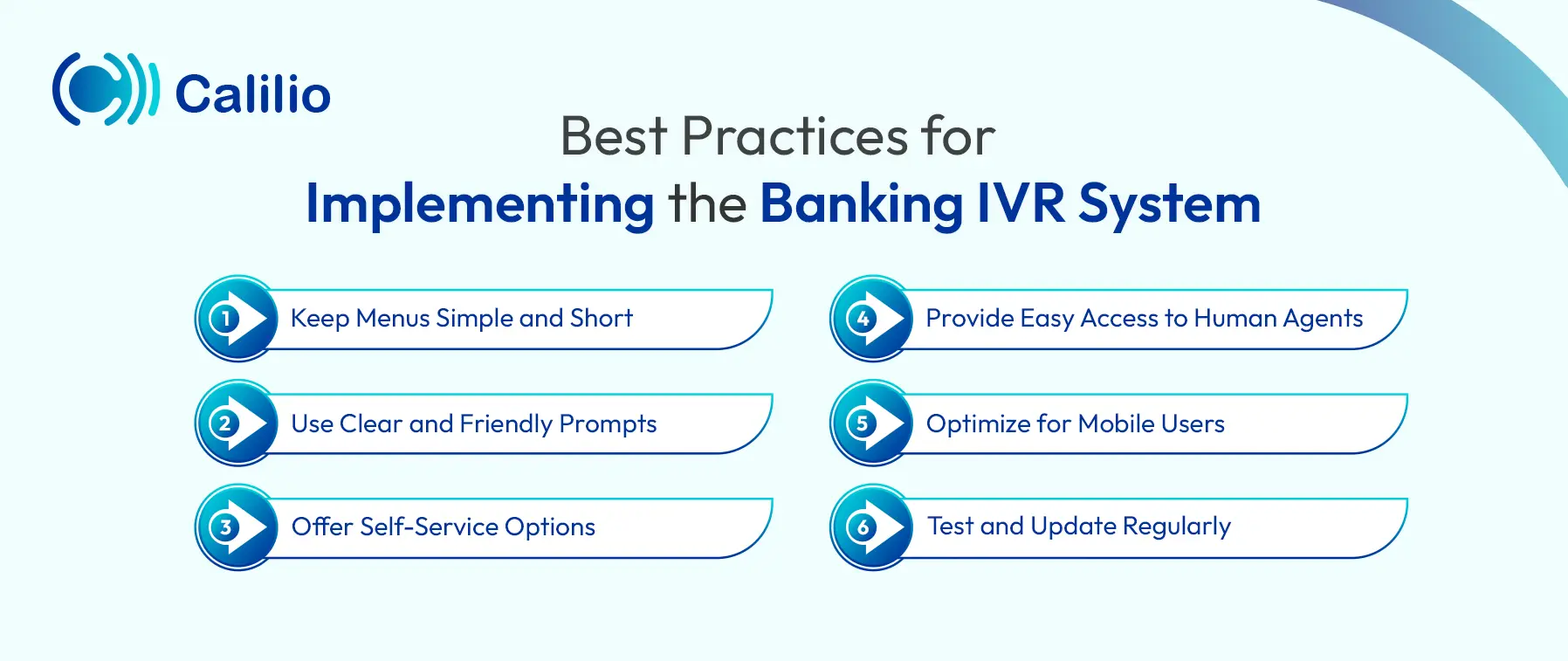IVR in Banking Sector: What It Is, How It Works, and Why It Matters

Banks often face the challenge of handling high volumes of customer calls during peak times. With limited staff available, agents may get overwhelmed with even routine customer inquiries. This results in longer wait times, increased operational costs, and a decline in service quality, ultimately affecting both the bank’s efficiency and customer satisfaction.
IVR in banking offers a practical solution by automating routine tasks like fund transfers, checking balances, paying bills, and so on. This improves efficiency, saves costs, and helps your bank deliver better service to a larger number of customers.
In this blog, we’ll explore what IVR in banking is, how it works, its key use cases, and the benefits it brings to both banks and customers. We’ll also highlight best practices and must-have features for implementing an effective IVR system in the banking sector.
Key Highlights:
IVR in banking is a telephony feature that allows customers to interact with a bank’s phone system using designated prompts for inquiries and services.
Banking IVR enables customers to quickly check their balances, review transactions, or report lost cards independently.
IVR enhances bank services by providing 24/7 availability, reducing costs, and improving security and efficiency.
IVR in the banking sector should offer ease of use, security, call routing, multilingual support, CRM integration, and real-time analytics for optimal performance.
To optimize IVR performance in a bank, keep menus simple, ensure easy access to human agents if needed, and regularly test the system.
What is IVR in Banking?
Interactive Voice Response (IVR) in banking is a telephony feature that allows customers to interact with a bank’s phone system using voice commands or keypad inputs for inquiries and services. It resolves customers’ common queries and provides access to the basic banking services, like checking balances or making payments without a human assistant.
Instead of speaking to a live agent, customers can simply follow voice or text menus to complete tasks. The system guides them step by step using pre-recorded options.
Route All the Calls in Your Financial Institution to the Right Department!
How does IVR in Banking Work?
IVR in banking works by automating customer interactions through phone menus. When a customer calls, the system greets them and presents a menu of options. The customer selects an option using their phone's keypad or voice, and the IVR system processes the request, providing information or routing the call to the right department.
Here’s the step-by-step breakdown of how IVR works in the banking sector.
- Customer Makes a Call: A customer calls the bank’s IVR number.
- Greeting: The IVR system answers with a recorded greeting, like, "Welcome to XYZ Bank. How can we assist you today?"
- Menu Options: The system provides several options for the customer to choose from, such as:
- Press 1 for account balance.
- Press 2 for recent transactions.
- Press 3 to make a payment.
- Press 4 to speak with a representative.
- User Selection: The customer selects an option by pressing the corresponding number on their phone’s keypad.
- Transaction Completion: The IVR system processes the customer’s request. Customers can independently complete tasks such as paying bills, viewing account activity, transferring funds, balance checks, and activating cards, among others.
- Call Escalation: If the issue is complex or the customer needs help, they can press a key to speak to a live agent.
- Call End: Once the task is completed, the system offers an option to end the call or stay on the line for more assistance.
Use Case of IVR System in Banking
IVR systems in banking are used to provide customers with self-service options for tasks like checking account balances, conducting transactions, and tracking loan applications. Banks can also use the IVR system to protect online accounts, allowing access only to authorized users through secure verification steps.

Managing Account Information
Managing account details is a routine yet essential need for banking. With an IVR setup, customers can simply call their bank and retrieve real-time account details without needing to wait for an agent to assist them. The system guides them through menu options to access the information they need in just a few taps or voice commands.
Conducting Financial Transactions
With a well-integrated IVR system, customers can carry out basic financial transactions through a guided, voice-enabled process. By following secure prompts, users can transfer money between accounts, make IVR payments, and even schedule recurring transactions. This is all done over a phone call.
Security and Fraud Prevention
IVR systems in banking provide multiple layers of security to protect customer accounts and prevent fraudulent activity. These systems utilize PINs, security questions, and voice biometrics to ensure that only authorized individuals can access sensitive account information. Additionally, with outbound IVR, banks can quickly call customers and alert them to any unusual transactions or potential fraud.
Loan Applications and Status
IVR systems in banking allow customers to inquire about loan products, apply for a loan, or check the status of their application. Customers can call in, follow the voice prompts, and receive instant updates on their loan applications.
What Are the Advantages of IVR in Banking?
IVR in the banking sector offers 24/7 customer availability, reduced operational costs, and minimizes wait times by automating common tasks and streamlining call routing. It also enhances transaction security with PINs and voice recognition, while providing multilingual support to serve a diverse customer base.
1. 24/7 Customer Availability
IVR provides 24/7 access to customers even after business hours, on weekends, and whenever necessary. It allows clients to address their banking concerns at a time of their preference.
2. Reduced Operational Costs
By automating common tasks, IVR systems reduce the need for many customer service agents. This helps the bank save money, which could lead to better services or lower fees for customers.
3. Shorter Wait Times
IVR provides immediate access to common services without the need for human assistance, reducing wait times. In case agent help is needed, it can efficiently route calls to the right department instantly for faster support.
4. Increased Transaction Security
AI-powered IVR systems use PINs and voice recognition to make sure that only the right person can access their account. This extra layer of security helps protect customers’ information from unauthorized access.
5. Multilingual Support for Diverse Customers
Most IVR systems offer multiple language options, so customers from different backgrounds can choose the language they’re most comfortable with. This makes it easier for everyone to use the system.
6. Reduced Human Error
By automating tasks, IVR systems minimize the risk of human error. This increases reliability and reduces mistakes that may occur during manual handling.
What are the Key Features to Consider in an IVR System for Banking?
Consider the system’s ease of use, security, call routing capability, multilingual support, CRM integration, and real-time analytics. These features ensure a seamless, secure, and efficient customer experience while supporting better service management and compliance.
Ease of Use
The IVR should be easy for customers to navigate, even for those with minimal technological knowledge.
Security and Compliance
The IVR system must comply with banking regulations and industry standards, such as GDPR or PCI DSS. These laws ensure that all customer interactions are secure and meet legal requirements.
Natural Language Processing (NLP)
NLP allows customers to speak naturally to the IVR instead of using keypad inputs. This makes the system more human-like, helping callers get what they need faster without going through multiple menu options.
Call Routing
The system should efficiently direct customers to the right department or agent while managing call queues.
Multilingual Support
If your bank serves customers of multiple language backgrounds, multilingual IVR is essential. It allows callers to interact in their preferred language. Supporting multiple languages also shows cultural awareness, helping your bank build stronger relationships with a wider client base.
Integration with CRM
Connecting your IVR system with your bank’s CRM allows the IVR to access customer details like account history, previous interactions, and preferences. When a customer calls your bank, it can provide personalized service and quicker issue resolution based on their past behavior.
Best Practices for Implementing the Banking Ivr System
To provide a seamless IVR experience for your customers, focus on addressing common needs with clear voice prompts and a well-organized menu. Additionally, make sure the system works well on mobile devices and gives users an easy way to reach a human agent when needed.

- Keep Menus Simple and Short: Keep options clear and concise to help customers find what they need quickly.
- Use Clear and Friendly Prompts: Ensure the voice prompts are easy to understand. A friendly, professional tone will make the experience more pleasant for customers.
- Offer Self-Service Options: Allow customers to complete common tasks and queries without speaking to an agent. This reduces wait times and improves customer satisfaction.
- Provide Easy Access to Human Agents: Always offer an option to connect with an agent if the customer needs help beyond the IVR’s capabilities.
- Optimize for Mobile Users: Ensure that the IVR system works well across all devices, including smartphones, as most customers prefer to access banking services through their phones.
- Test and Update Regularly: Regularly test the IVR system to identify issues and gather feedback. Keep the system updated to improve functionality and ensure smooth operation.
Conclusion
IVR systems are transforming the banking industry by automating routine customer interactions, offering 24/7 banking support, and improving both efficiency and security.
But the real power of IVR for banking is how it can shift customer satisfaction while easing operational workload. Equipped with the right system, banks can handle high volumes of calls, eliminate human error, and deliver personalized, multilingual service.
Frequently Asked Questions
Is IVR banking safe for financial transactions?
Yes, with modern security standards like encryption and verification steps, IVR banking is a highly secure channel for financial transactions.
Can IVR systems handle high call volumes?
Can small banks also use an IVR system?

Still have questions?
Can’t find the answer you’re looking for? Please chat with our friendly team.
Stay in the loop
Get the latest call insights, trends, and updates delivered straight to your inbox.
By subscribing, you agree to receive updates from Calilio.
You can unsubscribe anytime.
Phone numbers
Get International Phone Numbers
Singapore
|Australia
|New Zealand

